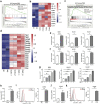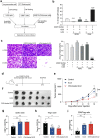Group 2 innate lymphoid cells boost CD8+ T-cell activation in anti-tumor immune responses
- PMID: 37577145
- PMCID: PMC10413917
- DOI: 10.1080/2162402X.2023.2243112
Group 2 innate lymphoid cells boost CD8+ T-cell activation in anti-tumor immune responses
Abstract
Group 2 innate lymphoid cells (ILC2s) are essential for orchestrating type 2 immune responses during allergic airway inflammation and infection. ILC2s have been reported to play a regulatory role in tumors; however, this conclusion is controversial. In this study, we showed that IL-33-activated ILC2s could boost CD8+ T-cell function through direct antigen cross-presentation. After activation by IL-33, ILC2s showed an enhanced potential to process antigens and prime CD8+ T cell activation. Activated ILC2s could phagocytose exogenous antigens in vivo and in vitro, promoting antigen-specific CD8+ T cell function to enhance antitumor immune responses. Administration of OVA-loaded ILC2s induces robust antitumor effects on the OVA-expressing tumor model. These findings suggested that the administration of tumor antigen-loaded ILC2s might serve as a potential strategy for cancer treatment.
Keywords: CD8 T cell; ILC2; anti-tumor response; antigen presentation.
© 2023 The Author(s). Published with license by Taylor & Francis Group, LLC.
Conflict of interest statement
No potential conflict of interest was reported by the authors.
Figures






Similar articles
-
Antigen Cross-Presentation by Type-2 Innate Lymphoid Cells Facilitates the Activation of Antitumor CD8+ T Cells.Cancer Res. 2025 Jul 15;85(14):2659-2678. doi: 10.1158/0008-5472.CAN-24-4194. Cancer Res. 2025. PMID: 40245114
-
IL-33-ILC2 axis promotes anti-tumor CD8+ T cell responses via OX40 signaling.Biochem Biophys Res Commun. 2022 Dec 31;637:9-16. doi: 10.1016/j.bbrc.2022.11.006. Epub 2022 Nov 5. Biochem Biophys Res Commun. 2022. PMID: 36375254
-
A novel type-2 innate lymphoid cell-based immunotherapy for cancer.Front Immunol. 2024 Mar 7;15:1317522. doi: 10.3389/fimmu.2024.1317522. eCollection 2024. Front Immunol. 2024. PMID: 38524132 Free PMC article.
-
Heterogeneity of ILC2s in the Intestine; Homeostasis and Pathology.Front Immunol. 2022 May 30;13:867351. doi: 10.3389/fimmu.2022.867351. eCollection 2022. Front Immunol. 2022. PMID: 35707544 Free PMC article. Review.
-
Group 2 innate lymphoid cells (ILC2s) are important in typical type 2 immune-mediated diseases and an essential therapeutic target.J Int Med Res. 2022 Jan;50(1):3000605211053156. doi: 10.1177/03000605211053156. J Int Med Res. 2022. PMID: 35048721 Free PMC article. Review.
Cited by
-
Dynamics of tissue repair regulatory T cells and damage in acute Trypanosoma cruzi infection.PLoS Pathog. 2025 Jan 30;21(1):e1012906. doi: 10.1371/journal.ppat.1012906. eCollection 2025 Jan. PLoS Pathog. 2025. PMID: 39883714 Free PMC article.
References
-
- Oliphant CJ, Hwang Y, Walker J, Salimi M, Wong S, Brewer J, Englezakis A, Barlow J, Hams E, Scanlon S, et al. MHCII-mediated dialog between group 2 innate lymphoid cells and CD4(+) T cells potentiates type 2 immunity and promotes parasitic helminth expulsion. Immunity. 2014;41(2):283–295. doi: 10.1016/j.immuni.2014.06.016. - DOI - PMC - PubMed
Publication types
MeSH terms
Substances
LinkOut - more resources
Full Text Sources
Research Materials
